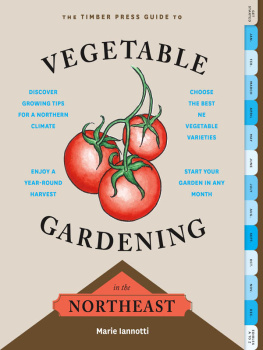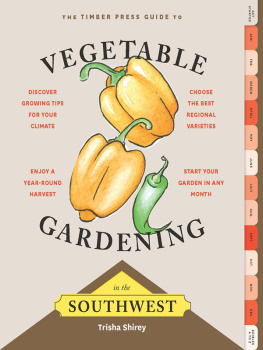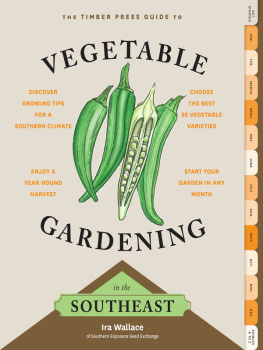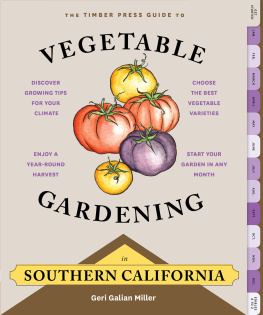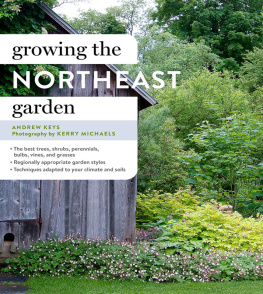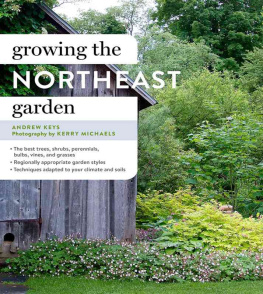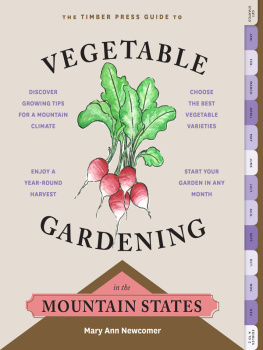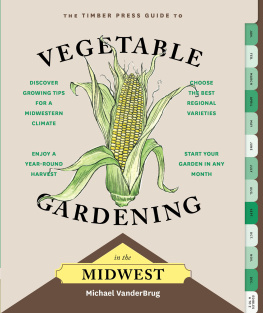THE TIMBER PRESS GUIDE TO VEGETABLE GARDENING
in the
NORTHEAST
MARIE IANNOTTI
Timber Press
_________________
Portland London
Copyright 2014 by Marie Iannotti.
All rights reserved.
Chapter opening illustrations by Kate Giambrone and Julianna Johnson
All other illustrations Julia Sadler
Published in 2014 by Timber Press, Inc.
The Haseltine Building
133 S.W. Second Avenue, Suite 450
Portland, Oregon 97204-3527
timberpress.com | 6A Lonsdale Road
London NW6 6RD
timberpress.co.uk |
Book design by Kate Giambrone and Julianna Johnson
Library of Congress Cataloging-in-Publication Data
Iannotti, Marie.
The Timber Press guide to vegetable gardening in the Northeast/Marie Iannotti.first ed.
p. cm.
Guide to vegetable gardening in the Northeast. Vegetable gardening in the Northeast.
Includes bibliographical references and index.
ISBN 978-1-60469-595-3
1.Vegetable gardeningNortheastern States. 2.VegetablesNortheastern States. I.Title. II.Title: Guide to vegetable gardening in the Northeast. III. Title: Vegetable gardening in the Northeast.
SB321.5.A115I26 2014
635.0974dc23
2013030869
TABLE OF
CONTENTS
Acknowledgments
Ive learned from so many extraordinary gardeners, its hard to know where to begin saying thank you. I appreciate every tip, every piece of advice, every seed or seedling, and especially every taste Ive so graciously been given over the years. It would be foolhardy to tell you there is only one way to garden in the Northeast. Gardening is an ongoing experiment in speculation, and nature is constantly changing the rules. A seasoned gardener is made from hands-in-the-soil experience and give and take with other gardeners. In this book, I share what Ive learned from both.
Books dont get written in isolation, either. I follow on the heels of authors Lorene Edwards Forkner and Ira Wallace, who got this series of books joyfully underway. Id be remiss in not mentioning my gratitude for my wonderful agent, Barb Doyen, who saw a book in me before I did (and for her Southwest gardening updates while my garden is still cloaked in snow). Once again, I am amazed by the team at Timber Press, especially Mollie Firestone and Juree Sondker, for their patience, skill, and unfailing guidance. And I was delighted to have another chance to work with Lisa Theobald, who can make sense of my thoughts, even when Im fumbling for them.
And, as always, huge thanks to my incredible husband, Michael, for never questioning my sanity as deadlines approach, in print or in the garden.
Preface
I cant look through a seed catalog without choosing enough varieties to plant a football fieldsized garden, with an appetite for more. Just thinking about vegetable gardening makes me hungry. Few things in this world can compete with biting into a freshly picked fruit or vegetable. The scents, the vibrancy, and the anticipation of that eruption of flavor make growing food an allsensory delight.
Very few edible plants cant be grown in the Northeast, especially if you are willing to push the seasonal envelope. Leafy greens, earthy root crops, luscious berries, and hearty winter squash are all ours for the growing. Our climate provides gardeners a warm, sunny summer and plenty of chill days for those exacting plants like rhubarb that need a rest between seasons (kind of like us gardeners). We take a brief pause to celebrate the holidays, and then we reach for our seed catalogs and the gardening season is back underway.
Vegetable gardening allows us to be part of the seasons and their changes. Although some people mark spring by the whims of a mercurial groundhog, there is no denying that spring has begun when we see the first green shoots of spinach, asparagus, or rhubarb. Its not summer until we can bite into a beefy, glowing tomato, and just when the garden is overflowing with abundance in early fall, the shortening days remind us that it is time to slow down. The Northeast vegetable garden may go under cover for the winterunder mulch, under plastic, or undergroundbut the process never ends; it just keeps re-creating itself in a most comforting, and often frustrating, way.
This book offers information for gardeners in several states and Canadian provinces: Connecticut, Delaware, Maine, Massachusetts, New Hampshire, New Jersey, New York, Pennsylvania, Rhode Island, Vermont, New Brunswick, Nova Scotia, Ontario, and Quebec. Our part of the world is the perfect place to enjoy the change of seasons, and each season brings its own reward. The information offered here will help you make sure you do not miss out on any of the gardening enjoyments the region has to offer, whether it is filling your winter home with sprouting greens and luscious fruits or the succession of harvests from the first spring thaw through the closing curtain of frost in the fall. The Northeast may be thought of as urban and industrial, but it is also home to some of the best farmers markets, locavore restaurants, and resilient gardeners who can turn any abandoned lot or alleyway into a feast for the soul.
Having four true seasons gives us the down time we need to plan and prepare our garden year, and getting the most from a vegetable garden does require a little advanced planning. Its all laid out for you in this book, including a year-round schedule to show what you can prepare, plant, and harvest each season. Whatever your level of gardening experience, you can jump in at any time and get up to speed. Read and digest it all at once, and keep it handy to guide you month by month.
Viewing your garden throughout the year is the best way to learn the intimate nuances of what each plant wants. That knowledge will serve you well, because no two years are the same. It is the rare spring when we can enjoy the gardening tradition of planting our peas on St. Patricks Day, but it is not unheard of. What I most hope you will glean from this book is the cycle of the garden and the role you play in keeping it moving forward. The Northeast offers a climate for savoring everything from arugula to zucchini; think about what you love to eat, and get ready to take it to another level.
GET STARTED
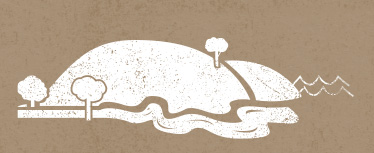
WELCOME TO THE NORTHEAST

The Northeast is an expansive, diverse area, where climates are affected by mountains, sheltered valleys, a long coastline, and assorted rivers and lakes. Soils tend to be rocky, and soil pH (the measure of acidity or alkalinity) depends on the predominant type of rock in the area. We can experience wide weather differences within a single zip code, but as the old saying goes, If you dont like the weather here, just wait a few minutes. As diverse as the region may appear, a few characteristics are shared throughout the NE. Winters may or may not be cold, but summers are always hazy, hot, and humid. Spring is often wetter than fall, and much of our annual precipitation comes from snow. We are positioned in a storm track that pulls cold air from the north and tropical storms from the Gulf Coast.

Climate Zones
Asking a gardener what zone he or she gardens in is an invitation for commiseration or envy. Plant hardiness zones tell us the length of an areas growing seasonwhen we can expect the first and last frosts of the seasons, which is crucial information for any gardener. Not all growing seasons are equal, however. Knowing the arc of your areas particular growing season will help you extend the time in which you can grow and harvest vegetables. Youll know when its safe to get started with frost-tolerant, leafy greens; when you can expect them to fizzle out and need replacing with plants that like it hot; and how long you can expect to enjoy every harvest.
Next page
